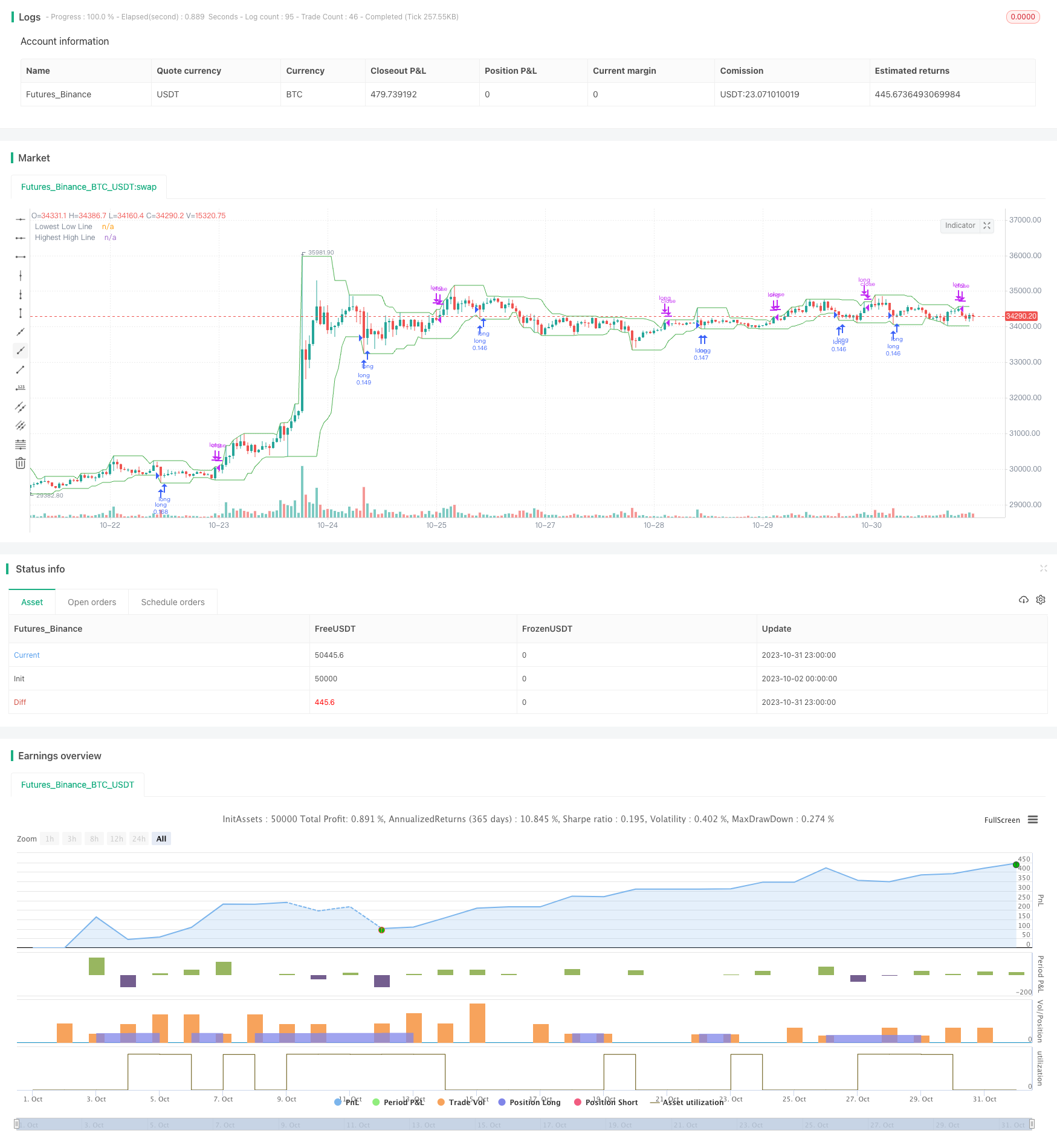Mean Reversion Breakout Low Strategy
Author: ChaoZhang, Date: 2023-11-02 15:34:22Tags:

Overview
The main idea of this strategy is to detect if the price breaks through the lowest price in a specified period and go long, waiting for the price to revert to the mean. It belongs to trend following strategies.
Strategy Logic
The strategy gets the lowest price in a specified period lowestLow using Pine Script’s ta.lowest method and compares it with the lowest price of the previous period prevLow.
If the latest period’s lowest price lowestLow is lower than the previous period’s lowest price prevLow, a long signal is triggered. After going long, it compares with the highest price in the specified period highestHigh. If the latest period’s highest price is greater than the previous highest price, it closes the position.
The strategy allows choosing the trigger condition, i.e. the lowest price needs to break through 1, 2, 3 or 4 previous lowest prices consecutively, to control the trading frequency.
It also plots the lowest price line lowestLow and highest price line highestHigh on the chart to visually display the trend change.
Advantage Analysis
-
The strategy catches the reversal trend after breaking new lows with relatively high win rate.
-
Allows choosing the number of broken lowest prices to control trading frequency.
-
Drawing the lines helps visually determine trend change points.
-
Simple and clear strategy logic, easy to understand and implement.
-
Can be configured and optimized on different stocks and time periods.
Risk Analysis
-
Breaking false bottom cannot determine trend reversal points, may lead to losses.
-
Needs to test different parameter combinations to optimize configurations, otherwise trading frequency may be too high or too low.
-
Parameters need to be adjusted for different stocks, should not mechanically apply.
-
Insufficient backtest period may cause overfitting.
-
Price may make new lows after breaking out, need to set stop loss to control risks.
Optimization Directions
-
Add stop loss mechanisms like moving stop loss, trailing stop loss, to limit per trade loss.
-
Optimize the number of breakouts to balance trading frequency and signal quality.
-
Test parameters on different stocks and time periods.
-
Add filters to avoid frequent trading in ranging markets.
-
Consider adding trend indicators to avoid counter trend trading.
-
Test different exit signals.
Conclusion
The strategy catches reversal opportunities by monitoring lowest price breakouts, a typical mean reversion breakout strategy. The advantages are simplicity, controllable frequency, and applicability to various stocks. But it also has some false breakout risks. Adding filters and optimizing is necessary, as well as controlling risks. With comprehensive testing and optimization, it can become a stable and reliable trading system.
/*backtest
start: 2023-10-02 00:00:00
end: 2023-11-01 00:00:00
period: 1h
basePeriod: 15m
exchanges: [{"eid":"Futures_Binance","currency":"BTC_USDT"}]
*/
// This source code is subject to the terms of the Mozilla Public License 2.0 at https://mozilla.org/MPL/2.0/
// © merovinh
//@version=5
strategy(title="Merovinh - Mean Reversion Lowest low",
overlay = true,
default_qty_type = strategy.percent_of_equity,
initial_capital = 10000,
default_qty_value = 10,
commission_type = strategy.commission.percent,
slippage = 1,
commission_value = 0.04)
GR_TIME = 'Time Period'
bars = input(9, title = "Minimum number of bars", tooltip = "The minimum number of bars before updating lowest low / highest high")
numberOfLows = input.string(defval='One', title='Number of broken lows', options=['One', 'Two', 'Three', 'Four'])
//Period
var prevLow = .0
var prevHigh = .0
var prevLow2 = .0
var prevLow3 = .0
var prevLow4 = .0
truetime = true
highestHigh = ta.highest(high, bars)
lowestLow = ta.lowest(low, bars)
if numberOfLows == 'One'
if truetime and prevLow > 0 and lowestLow < prevLow
strategy.entry('long', strategy.long)
if numberOfLows == 'Two'
if truetime and prevLow > 0 and lowestLow < prevLow and prevLow < prevLow2
strategy.entry('long', strategy.long)
if numberOfLows == 'Three'
if truetime and prevLow > 0 and lowestLow < prevLow and prevLow < prevLow2 and prevLow2 < prevLow3
strategy.entry('long', strategy.long)
if numberOfLows == 'Four'
if truetime and prevLow > 0 and lowestLow < prevLow and prevLow < prevLow2 and prevLow2 < prevLow3 and prevLow3 < prevLow4
strategy.entry('long', strategy.long)
if truetime and prevHigh > 0 and highestHigh > prevHigh
strategy.close('long')
if prevLow != lowestLow
prevLow4 := prevLow3
prevLow3 := prevLow2
prevLow2 := prevLow
prevLow := lowestLow
prevHigh := highestHigh
plot(lowestLow, color=color.green, linewidth=1, title="Lowest Low Line")
plot(highestHigh, color=color.green, linewidth=1, title="Highest High Line")
- Precise Trend Breakout Trading Strategy
- Bull Market Buy Dips Strategy
- DAKELAX-XRPUSDT Bollinger Band Mean Reversion Strategy
- Heiken Ashi and Super Trend Strategy
- Joanne on Crypto - Dual Moving Average with MACD Scalping Strategy
- Dynamic RSI Oscillation Trading Strategy
- Two-Stage Breakout Strategy
- Relative Strength Index RSI Strategy
- Bollinger Band T3 Moving Average Strategy
- BB Dual Long and Short Trading Strategy
- Dual Indicator Strategy
- EVWBB Strategy Based on EVWMA and Bollinger Bands
- MACD Trend Prediction Strategy
- Moving Average Ribbon Trend Strategy
- CCI and EMA Trend Following Trading Strategy
- Richard Bookstaber Momentum Breakout Strategy
- Dual Moving Average Strategy
- Adaptive Moving Average Channel Breakout Strategy
- Momentum Swing Effective Profit Strategy
- Hull Moving Average Trend Following Strategy